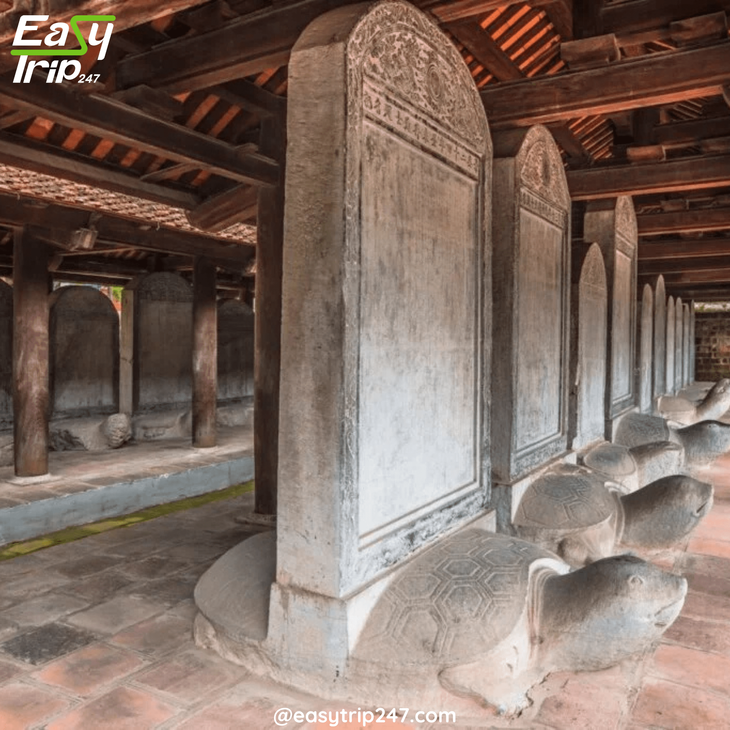10 Must-Know Facts About the Temple of Literature in Hanoi
On
23/06/2025Reading time:
1 min
Summary:
In the heart of Vietnam’s bustling capital lies a peaceful haven steeped in history, philosophy, and cultural pride — the Temple of Literature Hanoi. Often considered one of the most treasured landmarks in the city, this historical complex is more than just a monument; it's a tribute to Vietnam’s rich intellectual heritage and reverence for education.

1. Vietnam’s First University and a Symbol of Learning
The Temple of Literature Hanoi was originally built in 1070 under the reign of Emperor Lý Thánh Tông and later became home to the Imperial Academy — the first national university of Vietnam. Its purpose was to educate Vietnam's noble families and train future mandarins through Confucian teachings. It served as a learning center for nearly 700 years, making it one of the most enduring educational institutions in Vietnamese history. Today, the temple continues to symbolize the Vietnamese respect for education and intellectual achievement.
2. Dedicated to Confucius and His Disciples
While the name might imply a religious temple, the Temple of Literature Hanoi is actually a Confucian sanctuary. It is dedicated to Confucius, the great Chinese philosopher, as well as to his four closest disciples and other renowned Vietnamese scholars. Inside the temple, visitors will find altars and sacred halls honoring these intellectual pioneers, reflecting Vietnam’s deep cultural and moral admiration for Confucian principles such as righteousness, respect, and learning.
3. A Journey Through Five Courtyards
The layout of the Temple of Literature Hanoi consists of five tranquil courtyards, each with its own meaning and purpose. The first two courtyards feature landscaped gardens, old trees, and peaceful pathways that invite calm reflection. The third courtyard contains the Well of Heavenly Clarity, flanked by the famous stone turtles. The fourth and fifth courtyards are more scholarly, housing altars, statues, and what remains of the Imperial Academy. Walking through these courtyards is like taking a symbolic journey through the stages of academic enlightenment.
4. The Stelae of Doctors — Vietnam’s Scholarly Legacy in Stone
One of the most iconic features of the Temple of Literature Hanoi is the collection of 82 stone stelae, mounted on the backs of turtles — sacred symbols of wisdom and longevity. These stelae commemorate scholars who passed the royal exams between the 15th and 18th centuries. They bear the names, hometowns, and academic achievements of each graduate, serving as a historical record of Vietnam’s brightest minds. Even today, students visit these stones to seek blessings before important exams.
5. A National Treasure in the Midst of Hanoi
Despite being located in the energetic city center, the Temple of Literature Hanoi remains a peaceful escape for both locals and tourists. Its ancient architecture, quiet courtyards, and timeless atmosphere offer a rare glimpse into Vietnam’s scholarly past. Designated as a national historical site, the temple is often used as the backdrop for official events, cultural celebrations, and graduation photo sessions — further embedding it in modern Vietnamese life.
6. Khue Van Pavilion: A Symbol of Hanoi
Standing tall in the second courtyard, the Khue Van Pavilion is the architectural highlight of the Temple of Literature Hanoi. Built in 1805, this elegant structure features wooden beams, slatted windows, and a tiled roof — a blend of traditional Vietnamese design and Confucian symmetry. It is considered such a significant cultural symbol that it appears on Vietnam’s 100,000 VND banknote. Many photographers consider this the most beautiful spot in the temple grounds.
7. A Living Venue for Cultural Exchange
Today, the Temple of Literature Hanoi is more than a historical monument — it’s a vibrant cultural venue. Throughout the year, the temple hosts calligraphy exhibitions, music performances, and Tet holiday festivities. During the Vietnamese Lunar New Year, you’ll often find masters of traditional script offering hand-written blessings on red paper. These cultural events keep the spirit of the Temple of Literature Hanoi alive, attracting locals and tourists who want to witness or participate in Vietnam’s living traditions.
8. Architectural Brilliance Reflecting Confucian Ideals
The architecture of the Temple of Literature Hanoi follows a classical Chinese model but is deeply infused with Vietnamese identity. Everything from the symmetry of its courtyards to the simplicity of its buildings reflects Confucian values of order, respect, and harmony. Its wooden altars, red lacquer interiors, lotus ponds, and dragon motifs create a visual story of a culture that honors its past while staying spiritually grounded.
9. A Popular Site for Students and Families
The Temple of Literature Hanoi is a place where generations gather. Students visit to pray for academic success, newlyweds come for auspicious photo shoots, and families stroll the grounds to share the beauty of Vietnamese heritage with younger generations. Graduation season transforms the temple into a joyful gathering place filled with young people dressed in traditional áo dài. It's a space where history meets hope for the future.
10. Easily Accessible and Tourist-Friendly
Conveniently located about 10 minutes from the Hoan Kiem Lake area, the Temple of Literature Hanoi is very accessible by foot, taxi, or cyclo. Its admission fee is modest, and signage is available in multiple languages, making it an inviting stop for travelers. Whether you’re part of a guided cultural tour or exploring independently, the temple offers a peaceful yet profound experience you won’t forget.
Final Thoughts
The Temple of Literature Hanoi is more than just a relic of the past — it’s a living testament to Vietnam’s unwavering respect for education, culture, and community. With its harmonious design, deep-rooted symbolism, and historical resonance, the temple tells the story of a nation that cherishes its intellectual legacy. Visiting the Temple of Literature Hanoi isn’t just about seeing ancient buildings — it’s about stepping into a sacred space where the wisdom of the past continues to inspire the future. Whether you're exploring Hanoi for the first time or returning for another look, make sure this cultural gem is on your itinerary. You’ll leave with more than just photos; you’ll carry a deeper appreciation for the values that have shaped Vietnamese society for nearly a millennium.
Design Your Tour Today And Get A Quote. Contact Us Here: +84.975.504.825
Source: Easytrip247 Team compiled.
